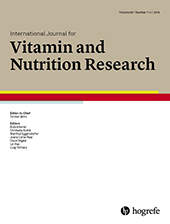The Weight Loss Effects of Branched Chain Amino Acids and Vitamin B6: A Randomized Controlled Trial on Obese and Overweight Women
Abstract
Abstract. Branched chain amino acids (BCAA), with vitamin B6 have been reported to improve fat metabolism and muscle synthesis. We hypothesized that supplementation with BCAA and vitamin B6 would result in more weight loss and improve body composition and blood markers related to cardiovascular diseases. Our aim was to determine whether the mentioned supplementation would affect weight loss, body composition, and cardiovascular risk factors during weight loss intervention. To this end, we performed a placebo-controlled randomized clinical trial in 42 overweight and obese women (BMI = 25–34.9 kg/m2). Taking a four-week moderate deficit calorie diet (–500 kcal/day), participants were randomized to receive BCAA (6 g/day) with vitamin B6 (40 mg/day) or placebo. Body composition variables measured with the use of bioelectrical impedance analysis, homeostatic model assessment, and plasma insulin, Low density lipoprotein, High density lipoprotein, Total Cholesterol, Triglyceride, and fasting blood sugar were measured. The result indicated that, weight loss was not significantly affected by BCAA and vitamin B6 supplementation (–2.43 ± 1.02 kg) or placebo (–1.64 ± 1.48 kg). However, significant time × treatment interactions in waist to hip ratio (P = 0.005), left leg lean (P = 0.004) and right leg lean (P = 0.023) were observed. Overall, supplementation with BCAA and vitamin B6 could preserve legs lean and also attenuated waist to hip ratio.
Literature
JAMES, PT. (2004) Obesity: The Worldwide Epidemic. CLIN DERMATOL. 22, 276–280.
Mahan, LK. Raymond, JL. (2016) Krause’s food & the nutrition care process: Elsevier Health Sciences.
Stiegler, P. Cunliffe, A. (2006) The role of diet and exercise for the maintenance of fat-free mass and resting metabolic rate during weight loss. SPORTS MED. 36, 239–362.
Amatruda, JM. Statt, MC. Welle, SL. (1993) Total and resting energy expenditure in obese women reduced to ideal body weight. J CLIN INVEST. 92, 1236.
Busquets, S. Alvarez, B. Llovera, M. et al. (2000) Branched-chain amino acids inhibit proteolysis in rat skeletal muscle: mechanisms involved. J CELL PHYSIOL. 184, 380–384.
Garlick, PJ. Grant, I. (1988) Amino acid infusion increases the sensitivity of muscle protein synthesis in vivo to insulin. Effect of branched-chain amino acids. BIOCHEM J. 254, 579–584.
Lynch, CJ. Adams, SH. (2014) Branched-chain amino acids in metabolic signalling and insulin resistance. NAT REV ENDOCRINOL. 10, 723–736.
Mourier, A. Bigard, A. De Kerviler, E. et al. (1997) Combined effects of caloric restriction and branched-chain amino acid supplementation on body composition and exercise performance in elite wrestlers. INT J SPORTS MED. 18, 47–55.
Kaimoto, T. Shibuya, M. Nishikawa, K. Maeda, H. (2013) High incidence of lipid deposition in the liver of rats fed a diet supplemented with branched-chain amino acids under vitamin B 6 deficiency. J NUTR SCI VITAMINOL. 59, 73–78.
Rajendram, R. Preedy, VR. Patel, VB. (2015) Branched Chain Amino Acids in Clinical Nutrition, Springer.
Shah, S. Crosslin, D. Haynes, C. et al. (2012) Branched-chain amino acid levels are associated with improvement in insulin resistance with weight loss. DIABETOLOGIA. 55, 321–330.
She, P. Van Horn, C. Reid, T. et al. (2007) Obesity-related elevations in plasma leucine are associated with alterations in enzymes involved in branched-chain amino acid metabolism. AM J PHYSIOL-ENDOC M. 293, E1552-E63.
Zemel, MB. Bruckbauer, A. (2013) Effects of a leucine and pyridoxine-containing nutraceutical on body weight and composition in obese subjects. Diabetes Metab. Syndr. Obes. Target Ther. 6, 309–315.
Rodríguez-Rodríguez, E. López-Sobaler, A. Navarro, A., et al. (2008) Vitamin B6 status improves in overweight/obese women following a hypocaloric diet rich in breakfast cereals, and may help in maintaining fat-free mass. INT J OBESITY. 32, 1552–1558.
Gonzalez-Correa, C. Caicedo-Eraso, J. (2012) Bioelectrical impedance analysis (BIA): a proposal for standardization of the classical method in adults. J PHYS CONF SER: IOP Publishing. 407, 012018.
Ichikawa, K. Okabayashi, T. Maeda, H. et al. (2013) Oral supplementation of branched-chain amino acids reduces early recurrence after hepatic resection in patients with hepatocellular carcinoma: a prospective study. SURG TODAY. 43, 720–726.
Zemel, MB. Bruckbauer, A. (2012) Effects of a Leucine and Pyridoxine-Containing Nutraceutical on Fat Oxidation, and Oxidative and Inflammatory Stress in Overweight and Obese Subjects. NUTRIENTS. 4, 529–541.
Mourier, A. Gautier, J-F. De Kerviler, E. et al. (1997) Mobilization of visceral adipose tissue related to the improvement in insulin sensitivity in response to physical training in NIDDM: effects of branched-chain amino acid supplements. DIABETES CARE. 20, 385–391.
Negro, M. Giardina, S. Marzani, B. Marzatico, F. (2008) Branched-chain amino acid supplementation does not enhance athletic performance but affects muscle recovery and the immune system. J SPORT MED PHYS FIT. 48, 347–351.
Zampieri, TT. Torres-Leal, FL. Campaña, AB. et al. (2014) L-leucine supplementation worsens the adiposity of already obese rats by promoting a hypothalamic pattern of gene expression that favors fat accumulation. NUTRIENTS. 6, 1364–1373.
Gojda, J. Rossmeislová, L. Straková, R. et al. (2017) Chronic dietary exposure to branched chain amino acids impairs glucose disposal in vegans but not in omnivores. Eur J Clin Nutr. 71, 594–601.
Institute of Medicine. (1998) Dietary Reference Intakes for Thiamin, Riboflavin, Niacin, Vitamin B6, Folate, Vitamin B12, Pantothenic Acid, Biotin, and Choline. National Academies Press.
Institute of Medicine (2005) Dietary Reference Intakes for Energy, Carbohydrate, Fiber, fat , Fatty Acids, Cholesterol, Protein, and Amino Acids. National Academies Press.
Areces, F. Salinero, JJ. Abian-Vicen, J. et al. (2014) A 7-day oral supplementation with branched-chain amino acids was ineffective to prevent muscle damage during a marathon. AMINO ACIDS. 46, 1169.


